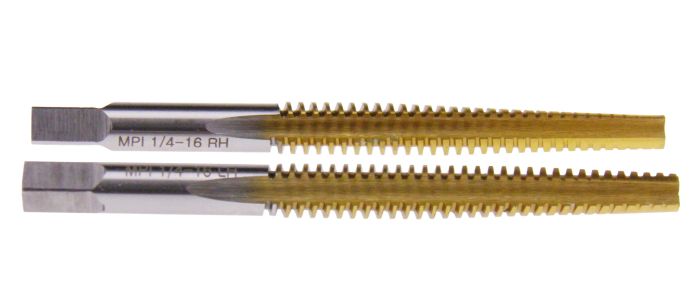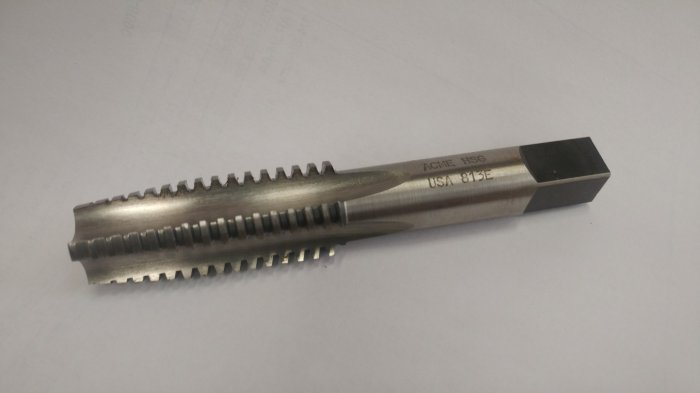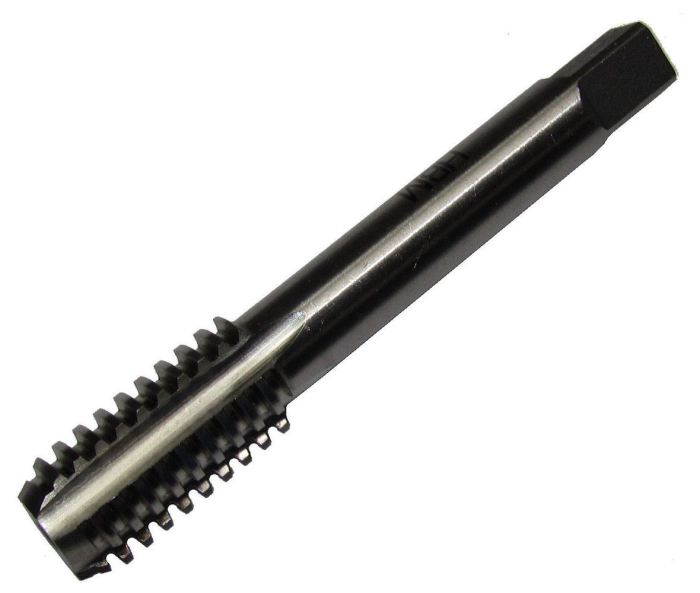Acme thread taps and dies, the cornerstone of precision threading, have played a vital role in manufacturing industries for decades. In this comprehensive guide, we delve into the world of these essential tools, exploring their applications, types, design, and maintenance.
From their humble beginnings to their modern-day advancements, acme thread taps and dies have continuously evolved to meet the demands of increasingly complex manufacturing processes. Their unique design and precise cutting capabilities make them indispensable tools for creating high-quality threaded components.
Overview of Acme Thread Taps and Dies

Acme thread taps and dies are specialized cutting tools used to create and repair threads in metal components. They are designed to produce a specific type of thread known as the Acme thread, which is characterized by its trapezoidal shape and high strength.
Purpose and Applications
- Acme thread taps are used to cut internal threads in holes, while Acme thread dies are used to create external threads on rods or bolts.
- These tools are commonly employed in industries such as automotive, construction, and manufacturing, where high-strength, durable threads are required.
- Acme threads are particularly suitable for applications involving heavy loads, such as power transmission and lifting mechanisms.
History and Evolution
The Acme thread was invented in the late 19th century by the American engineer George Albert Burley. It was initially used in bicycles and other machinery, and has since become a widely adopted standard for high-strength threads.
Acme thread taps and dies have evolved over time, with improvements in materials and manufacturing processes. Today, these tools are typically made from high-quality tool steel or carbide, ensuring durability and precision in cutting operations.
Types of Acme Thread Taps and Dies

Acme thread taps and dies come in various types, each designed for specific applications and materials. Understanding these variations is crucial for selecting the appropriate tool for your threading needs.
Acme Thread Taps
Acme thread taps are primarily used to create internal threads in materials. Different types of acme thread taps include:
- Hand Taps:Designed for manual threading operations, these taps are held and rotated by hand using a tap wrench.
- Machine Taps:Intended for use in machine tapping operations, these taps are mounted in a tapping head or chuck and driven by a machine.
- Bottoming Taps:These taps have a longer length of thread and are used to create threads that extend to the bottom of a blind hole.
Acme Thread Dies
Acme thread dies are utilized to cut external threads on rods or bolts. Common types of acme thread dies include:
- Round Dies:Have a cylindrical shape and are held in a die stock or die holder for manual threading operations.
- Square Dies:Feature a square cross-section and are commonly used in machine threading operations.
- Hex Dies:Have a hexagonal shape and are suitable for threading hexagonal bolts or rods.
Materials and Manufacturing of Acme Thread Taps and Dies

Acme thread taps and dies are typically constructed from high-quality materials to ensure durability and precision. The most common material used is high-speed steel (HSS), known for its hardness and resistance to wear. Other materials include tool steel, alloy steel, and carbide.
The manufacturing process of acme thread taps and dies involves several steps, each contributing to the tool’s accuracy and performance. The initial step is forging or casting the raw material into the desired shape. This is followed by heat treatment to enhance the material’s properties, such as hardness and toughness.
The next step is precision grinding to create the cutting teeth and threads. Finally, the tools are coated with a protective layer, such as titanium nitride, to increase their durability and reduce friction.
Manufacturing Process, Acme thread taps and dies
- Forging or Casting:The raw material is heated and shaped into the desired form using forging or casting techniques.
- Heat Treatment:The forged or cast material undergoes heat treatment to enhance its properties, such as hardness and toughness.
- Precision Grinding:The cutting teeth and threads are precisely ground to achieve the desired shape and dimensions.
- Coating:A protective coating, such as titanium nitride, is applied to the tools to increase their durability and reduce friction.
Design and Specifications of Acme Thread Taps and Dies
Acme thread taps and dies are designed with specific features to ensure efficient threading and accurate thread profiles. They adhere to industry standards and specifications to guarantee consistent performance and interchangeability.
Acme thread taps and dies, known for their durability and precision, are essential tools in any workshop. As I delve into my own creative journey, like the exploration described in into my own robert frost , I find that the same principles of craftsmanship apply.
Just as the threads of an acme tap engage with the workpiece, our own experiences shape our creativity and help us forge a unique path.
Acme thread taps typically have a straight flute design with a 29-degree cutting angle, providing smooth chip removal and reduced friction during tapping. Dies, on the other hand, feature a split-die design with adjustable chasers that allow for precise thread cutting and adjustment of thread size.
Specifications and Standards
Acme thread taps and dies are manufactured according to various specifications and standards, including:
- ANSI B1.5: American National Standard for Acme Threads
- ISO 2901: International Standard for Acme Threads
- DIN 103: German Standard for Acme Threads
These standards define the thread profile, pitch, and tolerance limits for Acme threads, ensuring compatibility and interchangeability of taps and dies from different manufacturers.
Applications of Acme Thread Taps and Dies

Acme thread taps and dies are versatile tools used in various industries and applications, particularly in manufacturing processes that require precision threading. They are commonly employed in the following sectors:
- Automotive:Acme threads are used in automotive components such as steering gears, brake systems, and transmission parts.
- Aerospace:Acme threads are found in aircraft landing gear, control systems, and hydraulic components.
- Machinery:Acme threads are used in machine tools, presses, and other industrial machinery for positioning and adjustment purposes.
- Medical:Acme threads are used in medical devices such as surgical instruments and prosthetic implants.
- Construction:Acme threads are used in construction equipment, such as jacks, scaffolding, and hoists.
In addition to these industries, acme thread taps and dies are also used in other applications, including:
- Creating precision threads in metalworking
- Repairing or replacing damaged threads
- Manufacturing threaded fasteners, such as bolts and nuts
- Producing custom threaded components
- Maintaining and servicing equipment with threaded parts
Advantages and Disadvantages of Acme Thread Taps and Dies
Acme thread taps and dies offer several advantages, including their strength, durability, and precision. These tools are designed to create strong, accurate threads in a variety of materials. They are also relatively easy to use, making them a good choice for both professional and DIY enthusiasts.However,
there are also some disadvantages to using acme thread taps and dies. These tools can be expensive, and they can potentially damage threads if they are not used properly.
Advantages
- Acme thread taps and dies are very strong and durable, making them ideal for use in demanding applications.
- These tools produce precise threads that are accurate and consistent.
- Acme thread taps and dies are relatively easy to use, even for beginners.
Disadvantages
- Acme thread taps and dies can be expensive, especially compared to other types of threading tools.
- These tools can potentially damage threads if they are not used properly.
Maintenance and Care of Acme Thread Taps and Dies

Acme thread taps and dies require proper maintenance and care to ensure optimal performance and longevity. Here are some key steps to follow:
Cleaning
- Regularly clean the taps and dies to remove chips, dirt, and other debris that can accumulate during use.
- Use a wire brush or compressed air to remove loose debris.
- For stubborn dirt, soak the tools in a cleaning solution specifically designed for metalworking tools.
Lubrication
- Apply a lubricant to the taps and dies before each use to reduce friction and prevent wear.
- Choose a lubricant that is suitable for the material being tapped or threaded.
- Avoid using excessive lubrication, as this can attract dirt and debris.
Storage
- Store the taps and dies in a dry, clean place when not in use.
- Protect them from moisture and corrosion by wrapping them in a cloth or placing them in a protective case.
- Avoid storing the tools in direct sunlight, as this can weaken the metal.
Top FAQs
What are the advantages of using acme thread taps and dies?
Acme thread taps and dies offer several advantages, including their strength, durability, and precision. They can produce high-quality threads in a variety of materials and are ideal for applications where accuracy and longevity are paramount.
What are the different types of acme thread taps?
There are several types of acme thread taps, including hand taps, machine taps, and bottoming taps. Each type is designed for a specific application, with hand taps being used for manual threading, machine taps for use in CNC machines, and bottoming taps for creating blind holes.
How do I properly maintain acme thread taps and dies?
Proper maintenance is essential for extending the life of acme thread taps and dies. Regular cleaning, lubrication, and storage in a dry environment can help prevent rust and damage. Additionally, it’s important to avoid using excessive force when threading, as this can lead to breakage.